

Philips Hue Festavia: can these fairy lights do more than twinkle?
Fairy lights that shine in Rio and Miami colours, flicker like a fire and can pulse to the beat of your favourite song? The Festavia string lights from Philips Hue are supposed to do it all. Here’s my review.
Firefighters won’t like what they’re about to read: up till recently, I’ve always had real candles on my Christmas tree. When critics questioned my choice, I always replied with the same, unconvincing answer: nothing has ever burned down.
But when the end of 2024 came round, I felt the need to set a good example and celebrate the faux tree after all. After testing [artificial Christmas trees],(/page/schlecht-bestueckt-bis-taeuschend-echt-kuenstliche-weihnachtsbaeume-im-vergleich-35753) I tested a set of fairy lights: the Festavia from Philips Hue.
Price, length and energy consumption: in the higher range
A quick note on the numbers: in terms of price, these fairy lights are in the slightly higher segment. If you compare them to other smart Christmas lights, like Twinkly, they’re up to three times more expensive (depending on the model). For this you get: 100 LEDs on an eight-metre cable (the model used in my review), 250 LEDs on a 20-metre cable or 500 LEDs on a 40-metre cable.
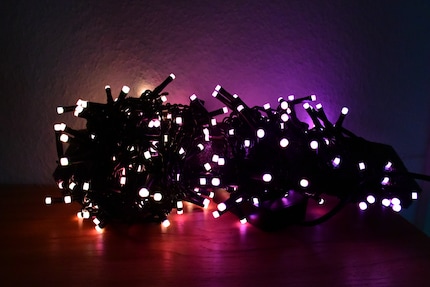
Source: Darina Schweizer
I was slightly confused by the indoor and outdoor use initially. On the packaging, it says the string lights are suitable for both. But under the safety instructions I read the following: «the product should be only be installed in closed rooms.» After a bit of research, I found out that Festavia string lights which were purchased after September 2023 are suitable for outdoor and indoor use.
It’s a bit of a shame that all the string lights are in energy efficiency class G – the worst. That might come as a surprise but I get it. Even energy efficient LEDs are landing in worse categories because of the strict EU criteria at the moment. Especially when they’re kitted with a number of additional settings. And Festavia has plenty of them. Let’s take a closer look!
Installation and light scenes: simple and versatile
I wrapped the Festavia around the 150-centimetre tree with the loose end starting at the tip. The eight-metre set should also be sufficient for a tree height of 180 centimetres or even two metres. To control the lights, you need the Philips Hue app. Without the app, the fairy lights will only shine in one colour. I downloaded the app, hooked up the fairy lights to the power supply and connected them to the app via Bluetooth. You can’t move too far away the first time you pair them. Once connected, pairing is very simple.
You’ll find a huge selection of light scenes in the app. They’re divided into the following categories:
- Mood (e.g. cosy, romantic, peaceful)
- Nature scenes (e.g. sunrise and sunset, galaxy, northern lights)
- Places (e.g. Honolulu, Tokyo, Chinatown)
- Activities/essentials (e.g. relaxing, reading, concentrating)
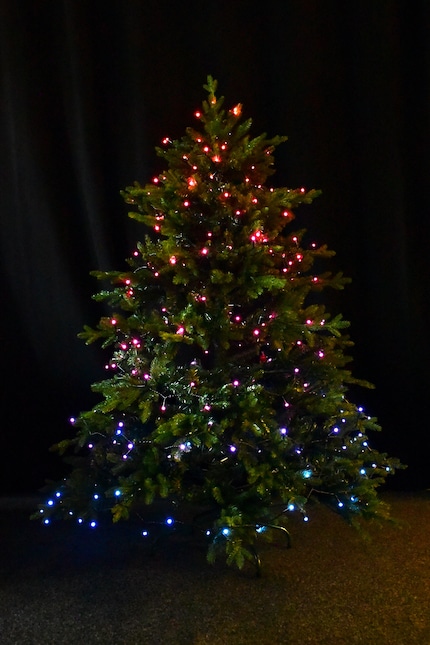
Source: Darina Schweizer
The colour composition of the lights appears under each scene in the form of colour blobs. If you particularly like a scene, you can save it in «My scenes» – that way you have quick access to it from the start page. You can also create «automations» – this enables you to control what times the fairy lights turn on and off. Or whether they accompany you to sleep with the dimming function or to wake you up.
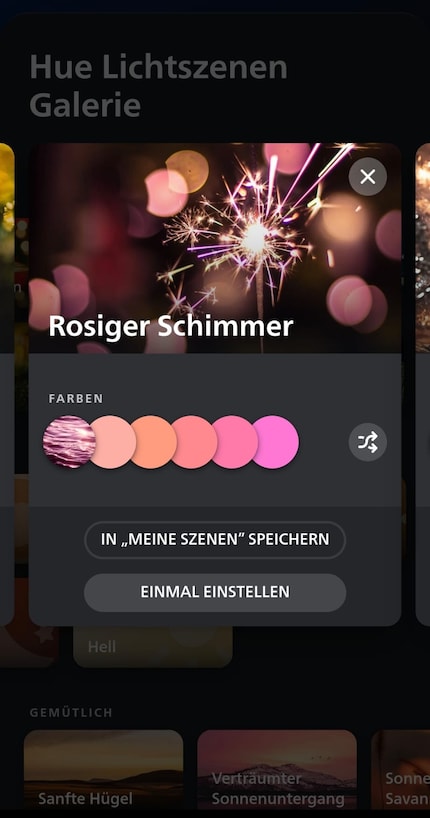
Source: Screenshot/Darina Schweizer
Customised effects and movement: only the essentials
The more I swiped through, the more I realised that many scenes were similar. If one day you get tired of them, you can create your own effects. When you go to «Festavia string lights», you can select up to three colour ranges from a colour palette and different modes. Let’s take blue and red for example; these are your options:
- Linear: The entire string is dyed with a colour gradient from blue to red.
- Scattered: Blue and red appear in random or scattered sections along the string of lights.
- Mirrored: The light string starts with blue on one side, changes to red and then returns to blue. Both ends of the string look identical.
You can also adjust the brightness. Once you’re done, you can save your creation under «My scenes».
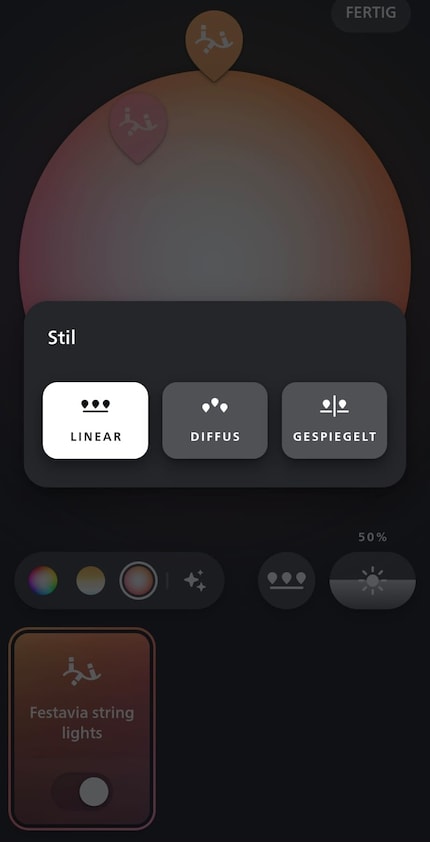
Source: Screenshot/Darina Schweizer
What I’m not a fan of is that there’s a restriction in the movement effects for the LED light interval. You can make the lights flicker like a candle flame, blaze like a chimney fire, ripple like a wave or sparkle like an emerald. You can also adjust the speed, brightness and colour. What you can’t do is combine the effects with lighting scenes to make the Tokyo scene pulsate, for example. Nevertheless, the movement effects have been greatly enhanced compared to the previous models. Updates and new functions are also constantly being added to the app. Overall, I like the selection of effects more than the cheaper competitor Twinkly’s – they flash a little too nervously for my liking.
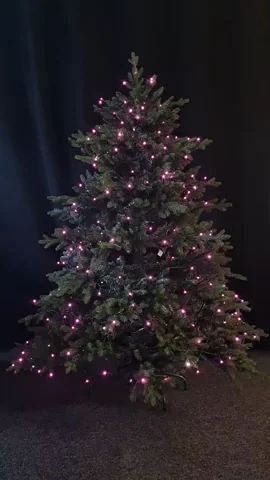
Source: Giphy.com/Darina Schweizer
Music synchronisation: just a funny gag
But now for the most important question: can the fairy lights really dance to the beat of my favourite hits? Before I could get carried away, I realised I needed a bridge to be able to use this additional function. For all Hue newcomers, this is the central control device that connects all Hue devices and enables smart control. It’s not included as standard with the string lights, so I ordered one.
First, I installed the bridge and synchronised it with my Spotify account. Unfortunately, it doesn’t work with other apps such as Apple Music. After I paired it with Spotify, a «Sync» button appeared at the bottom of the screen in the middle. This allows you to determine the style (classical or pulsating) and the general music speed the lights should match. Plus, you can select the colour and the brightness of the lights.
Let’s see it how it goes! I tried out Highway to Hell by ACDC. Surely a song with such a straightforward, clear beat shouldn’t be a problem for Festavia? I thought to myself. Ah well. The lights started to pulsate, but a few seconds too early. As the song progressed, the lights only flickered in the right rhythm occasionally. Even when I delayed it by two seconds, which I was able to set in the app, or tried other melodies (see video) it didn’t help.
At least other additions are possible: if I had other Hue lights in the living room, I could also combine their settings with the string lights. Or I could add further operating accessories such as a dimmer switch. The lights can also be controlled by voice command via smart home assistants such as Alexa, Siri or Google Assistant. And in case you can’t get enough of fairy lights: you can connect as many Festavias to the power supply unit (as well as to a Hue low-voltage system outdoors) until the maximum 30 watts are reached. Eight-metre strings consume seven watts, 20-metre strings 14 watts and 40-metre strings 28 watts.
That should be enough to get you through the dark winter months.
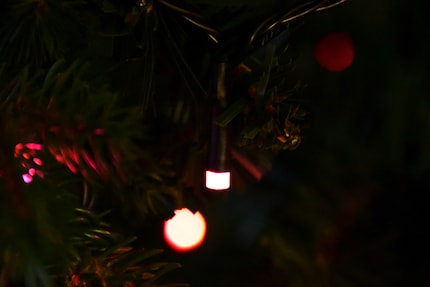
Source: Darina Schweizer
In a nutshell
Multitalented but has its limits
The Festavia string lights by Philips Hue offer a wide range of classy light scenes. The range of motion effects is limited and more subtle, but put together more tastefully than other fairy lights.
The music synchronisation is an entertaining additional function. However, the beat isn’t accurate, which is why it remains a nice gimmick for the moment at best. Overall, Festavia is like a decoration that will bring joy for years to come. It’s high quality, can be integrated into existing Hue systems and, if needed, can be added to other lights on the same power supply to reach 30 watts. And, in my opinion, that justifies the large price tag.
Pro
- High quality
- Simple installation
- Easy app control
- Beautiful lighting scenes and motion effects
- Compatible with other Hue lights
- Suitable for indoor and outdoor use (for models from September 2023)
Contra
- Motion effects and music synchronisation could be improved

I love anything with four legs or roots - especially my shelter cats Jasper and Joy and my collection of succulents. My favourite things to do are stalking around with police dogs and cat coiffeurs on reportages or letting sensitive stories flourish in garden brockis and Japanese gardens.



